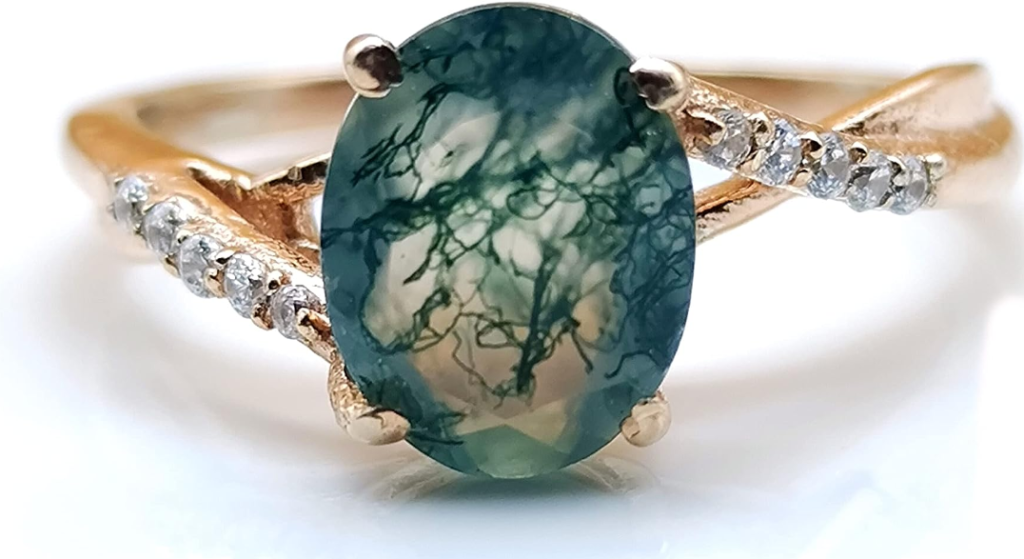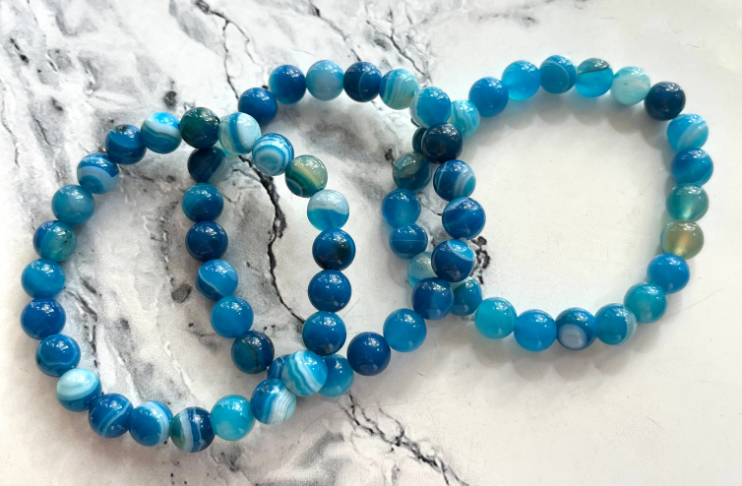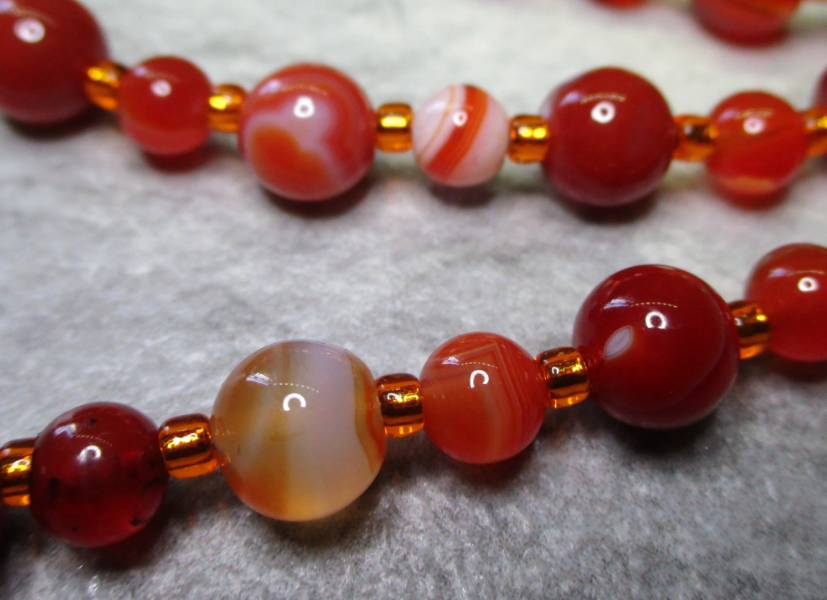Gemstones have long captured humanity’s fascination, not just for their intrinsic beauty but also for the myriad of stories, legends, and properties attributed to them.
Among these precious stones is agate—a naturally occurring rock formation primarily known for its fine-grained, vibrant, and often multi-colored bands. But does its aesthetic allure also translate to suitability in the jewelry world?
In this article, we delve into agate’s characteristics, its history, properties, and the reasons behind its ever-growing popularity in the jewelry industry.
Whether you’re a seasoned jeweler, an avid gem collector, or someone considering an agate piece for your next accessory, this exploration promises insights that will both enlighten and enchant you.
What is Agate?
Agate has been a stone of intrigue for centuries with its mesmerizing bands and diverse palette. But what exactly is this captivating gemstone, and how does it come to possess such a vast range of appearances?
Definition and Mineral Composition
Agate is a form of chalcedony, a microcrystalline variety of quartz. It is characterized by its fine grain and layered appearance. Its beautiful and often multi-colored banding patterns set agate apart from other chalcedonies.
These bands are formed over thousands, if not millions, of years, as mineral-rich water deposits layers of silica in cavities of host rocks. As the water evaporates, it leaves behind silica deposits that crystallize to form agate. Over time, variations in the mineral content cause different colorations and band patterns to emerge.
Varieties and Colors of Agate
Agate comes in an extensive range of colors and patterns, making it one of the most versatile gemstones for jewelry designers and enthusiasts. Some of the most popular varieties include:
Moss Agate: Unlike its name suggests, moss agate doesn’t have the banded appearance typical of other agates. Instead, it displays a beautiful pattern resembling moss or trees, caused by mineral inclusions.
Blue Lace Agate: As the name indicates, this type showcases soft blue bands that resemble lace, making it highly sought after for its calming appearance.
Fire Agate: This captivating variety is iridescent, showing off fiery reds, oranges, and browns that seem to glow from within.
Dendritic Agate: Recognized for its tree or fern-like inclusions, typically manganese or iron.
Crazy Lace Agate: Known for its intricate and swirling patterns, this variety displays a chaotic mix of colors and designs, each piece telling its own unique story.
Banded Agate: Perhaps the most recognized variety, it features distinct layers or bands of color, often contrasting, that runs through the stone.
The myriad of colors and patterns in agate is a testament to nature’s artistic prowess, allowing jewelry designers and wearers to choose from a spectrum that can cater to any taste or occasion.
Historical Significance of Agate in Jewelry
Agate is more than just a visual delight with its myriad of patterns and hues. Its usage in jewelry can be traced back to ancient civilizations. Understanding the historical significance of agate provides a richer appreciation for this versatile gemstone in contemporary jewelry.
Ancient cultures and their reverence for agate
Ancient societies around the world held agate in high regard, seeing it not just as a decorative gem but also attributing it with various powers and significances:
Ancient Egypt: Agate was esteemed for its protective properties. It was believed to shield against natural disasters and provide spiritual protection. Hieroglyphs often depict talismans made of agate.
Ancient Greece and Rome: Beyond just its aesthetic appeal, Greeks and Romans believed that agate could bestow upon its wearer the power to speak eloquently and soothingly. It was also considered a guardian against storms.
Ancient Asian Cultures: In ancient China and India, agate was often used in amulets and talismans, believed to bring good luck, enhance mental function, and calm anxieties.
Ancient Mesoamerica: Civilizations like the Mayans and Aztecs used agate in ceremonial masks and various artifacts, attributing it with powers of protection and strength.
Evolution of its use and popularity across different eras
As time progressed, the use and interpretation of agate evolved, but its allure remained ever-present.
Medieval Europe: Agate was used in ecclesiastical rings and was believed to keep the wearer safe from danger and even make them invisible in times of threat.
Renaissance: Artists and craftsmen began using agate extensively, not just for jewelry, but also in making cameos, seals, and mosaics. Its varied patterns and colors made it perfect for intricate artwork.
Victorian Era: The Victorian Age saw agate being used in brooches, rings, and necklaces. The stone became a favorite among the nobility and was often combined with other precious stones.
Modern Times: Today, agate remains popular in jewelry, celebrated for its historical significance and natural beauty. Contemporary jewelers incorporate it into innovative designs while respecting its ancient allure.

Properties that Make Agate Suitable for Jewelry
Here’s a detailed look at the properties that make agate a top choice for jewelry.
Variety of Colors and Patterns:
Agate comes in a wide array of colors, from rich blues, fiery reds, and calming greens to neutral earthy tones. Each piece can present with unique banding, specks, stripes, or patterns, ensuring that no two agate jewels are exactly alike.
This diversity means that agate can be selected to match various outfits, moods, or occasions. It also allows for vast creativity in jewelry design.
Durability and Hardness:
Agate scores between 6.5 to 7 on the Mohs scale of hardness, making it relatively hard and resistant to scratches as compared to other decorative stones.
This hardness ensures longevity and allows for everyday wear without the worry of the piece getting damaged easily.
Translucence:
Many agates are semi-translucent, which means they allow a certain amount of light to pass through. When crafted into jewelry, this property gives agate pieces a unique glow and depth that is particularly beautiful when held against the light.
Thermal Stability:
Agate can withstand temperature variations better than many other gemstones. This means that it doesn’t crack or lose its luster easily with minor temperature changes, which can sometimes occur during jewelry-making processes or while wearing.
Versatility in Crafting:
Agate can be shaped, sliced, polished, or even left in its raw form, allowing jewelers a broad canvas of possibilities. Whether it’s cabochon settings, beads, or intricate carvings, agate’s adaptability is noteworthy.
Chemical Robustness:
Agate’s resistance to common chemicals means that it’s less likely to suffer damage from accidental exposures, such as perfume sprays or lotions, making it a practical choice for everyday jewelry.
Unparalleled Uniqueness:
The innate patterns within agate are unique to each stone, ensuring that every piece of agate jewelry retains an unparalleled individuality and character.
Historical and Cultural Value:
Many cultures have revered agate for its supposed healing properties and spiritual significance. This rich history adds a layer of depth to its appeal, making it a gemstone that’s cherished not just for its looks but also for its heritage.
Cost-Effective Elegance:
Agate’s relative abundance means it offers a luxury look without the price tag. This accessibility allows more people to enjoy the beauty of agate jewelry without breaking the bank.
Ease of Care:
Agate jewelry doesn’t demand rigorous care routines. A gentle cleaning with mild soap and water is typically sufficient to maintain its sparkle and sheen.
Benefits of Wearing Agate Jewelry
Beyond its undeniable aesthetic allure, agate jewelry offers a blend of emotional, spiritual, and physical advantages. Here’s a deeper look into the multifaceted benefits of donning agate jewelry:
1. Emotional Stability: Many crystal enthusiasts and practitioners credit agate with grounding capabilities. Wearing agate jewelry can help balance one’s emotions, reduce feelings of anger, envy, or bitterness, and promote love and courage.
2. Enhanced Concentration: Agate is often regarded as a stone of focus and clarity. By wearing agate jewelry, some believe they can boost their analytical abilities and concentration, making tackling complex tasks or decisions easier.
3. Stress Relief: The calming energies associated with agate make it a popular choice for those seeking to alleviate stress and anxiety. Having a piece of agate jewelry close to the skin, such as a pendant or bracelet, might help in inducing feelings of tranquility and security.
4. Improved Sleep: Agate’s calming vibrations are also believed to aid in battling insomnia. Wearing agate jewelry, especially in the form of necklaces or earrings, might assist in achieving a deeper and more restful sleep.
5. Physical Healing: Some proponents claim that agate possesses the power to stimulate the digestive system, heal eyes, and even strengthen blood vessels. While scientific evidence is scant, many wearers of agate jewelry hold fast to these beliefs, trusting in the stone’s therapeutic properties.
6. Protection from Negative Energies: Throughout history, agate has been utilized as a protective amulet against negative energies and evil eyes. Wearing agate jewelry can be seen as a shield, guarding its wearer from external negative influences.
7. Boosting Self-Confidence: The empowering energies of agate can inspire self-confidence and self-acceptance. Adorning oneself with agate jewelry can be a constant reminder of one’s inherent strength and worth.
8. Strengthening Relationships: Agate, especially the pink variety, is linked with love and fidelity. Wearing agate jewelry might assist in enhancing relationships by promoting understanding and eliminating negativity.
9. Enhancing Spiritual Growth: Agate’s spiritual resonance aids in connecting with the universe and one’s inner self. It’s believed to enhance meditative practices, facilitating a more profound spiritual journey for its wearer.
10. Aesthetic Appeal and Versatility: Apart from the metaphysical benefits, let’s remember the simple joy of wearing something beautiful. Agate’s diverse patterns and colors make it a versatile gemstone that complements a range of outfits and occasions.
Caring for Agate Jewelry
While agate is renowned for its durability and captivating beauty, like all gemstones, it demands appropriate care to maintain its brilliance and ensure its longevity. Below are crucial aspects to consider when caring for your cherished agate jewelry.
Cleaning Methods to Maintain its Luster
Agate, with its intricate bands and patterns, can collect dirt and grime, especially if worn regularly. Here’s how to cleanse it effectively:
1. Mild Soap and Water: Prepare a bowl of lukewarm water and add a few drops of mild soap. Submerge your agate jewelry into the solution, allowing it to soak for a few minutes.
2. Soft Brushing: Using a soft-bristled brush, gently scrub the agate, paying particular attention to nooks and crevices where dirt might accumulate.
3. Rinsing: Thoroughly rinse the jewelry under cool running water to remove any soap residue.
4. Drying: Pat the jewelry dry with a soft, lint-free cloth. Ensure the piece is thoroughly dry before storing to prevent moisture buildup.
Tips for Storing to Prevent Scratches and Damage
Despite its relative hardness, agate can still be scratched by harder gemstones or abrasive materials. Adopt these storage techniques to keep your agate jewelry pristine:
1. Individual Pouches: Store each piece of agate jewelry in a separate soft pouch. This minimizes the risk of pieces rubbing against each other, causing potential scratches.
2. Away from Direct Sunlight: Extended exposure to direct sunlight can fade the color of some agate varieties. Store your agate jewelry in a shaded area or in a jewelry box.
3. Avoid Stacking: Refrain from stacking agate jewelry, especially rings or delicate pieces, on top of each other. This can lead to unnecessary pressure and potential scratches.
4. Maintain a Moderate Environment: Store your agate in an area with consistent humidity and temperature. Extreme changes can potentially harm the stone over time.
Protective Measures to Keep its Aesthetic Appeal Intact
For your agate jewelry to continue captivating gazes, observe the following protective measures:
1. Limit Exposure to Chemicals: Always remove your agate jewelry when using harsh chemicals, perfumes, or household cleaners. Such substances can dull the stone’s surface or cause discoloration.
2. Wearing Precautions: Put on your agate jewelry last when dressing up, ensuring it doesn’t come in contact with cosmetics or sprays.
3. Physical Activities: Remove your agate jewelry during vigorous activities, like sports or gardening, to avoid accidental impacts that might chip or crack the stone.
4. Routine Check-ups: Periodically, especially if set in a ring or bracelet, have your agate checked by a professional jeweler for any loose settings or potential issues.
In essence, with mindful care and attention, your agate jewelry will not only remain a treasured accessory for years to come but will also maintain its vibrant luster and mesmerizing patterns, serving as a testament to its enduring allure.

Considerations When Purchasing Agate Jewelry
When you’re in the market for an agate piece, it’s vital to be well-informed to ensure you get value for your money and buy responsibly. Here are some critical considerations:
Determining Genuine Agate vs. Imitations
Agate’s uniqueness can sometimes be mimicked using other materials or enhancements. Here’s how to discern the real deal:
1. Temperature Test: Genuine agate tends to feel cooler to the touch compared to glass or plastic imitations. Hold the stone in your hand; it might be an imitation if it warms up rapidly.
2. Examine Patterns: Authentic agate has irregular, often band-like patterns that are not perfectly symmetrical. If the patterns look too uniform or printed, be cautious.
3. Scratch Test: Agate, with a Mohs hardness of around 6.5 to 7, won’t be easily scratched by softer materials. However, always perform this test discreetly or on areas that won’t be visible when worn to avoid damage.
4. Price Point: If a deal seems too good to be true, it often is. Exceptionally cheap agate might be an indication of an imitation.
Importance of Considering the Source and Ethical Mining Practices
With growing awareness about responsible consumerism, the origin and mining practices associated with gemstones have become crucial:
Ethical Mining: Ensure that the agate is sourced from mines that observe ethical practices, ensuring fair wages and safe working conditions for miners.
Environmental Impact: Mines should also adhere to standards that minimize environmental degradation. Some agate mining can lead to habitat destruction if not managed correctly.
Transparent Sourcing: Reputable jewelers often provide details about where their agate is sourced. Seek this transparency to make an informed choice.
Support Local Artisans: Whenever possible, buy from local artisans or communities where agate mining plays a significant role in the economy. This ensures that profits go directly to those who need it most.
Evaluating Craftsmanship and Quality of the Jewelry Setting
The beauty of the agate stone should be complemented by the quality of its setting:
- Metal Quality: Check the quality of the metal used in the jewelry. Sterling silver, gold, or platinum settings often indicate a higher-quality piece.
- Setting Security: Ensure that the agate is securely set in its mounting. Prongs should be even and hold the stone without wobbling.
- Artistry: Look at the design intricacies. Superior craftsmanship will manifest in the detailing, finishing, and overall design coherence.
- Functionality: Clasps, hooks, and other functional parts of the jewelry should be sturdy and operate smoothly.
- Reviews and Recommendations: Especially when buying online, reviews can give insights into the craftsmanship and durability of a piece. Personal recommendations are equally valuable.
Notable Agate Jewelry Designers and Brands
Agate’s rich history and versatile appeal have caught the attention of numerous jewelry designers and brands. From high-end luxury creators to innovative contemporary artisans, agate continues to inspire. Let’s delve into some of the most notable names and the trends they’ve spearheaded.
A Glance at Renowned Artisans Specializing in Agate
1. Monica Vinader: With designs that elegantly blend modernity with timeless charm, Monica Vinader often employs agate to add depth and character to her pieces. Her bracelets and rings have especially garnered attention.
2. Jamie Joseph: Crafting jewelry that truly brings out the inherent beauty of gemstones, Jamie Joseph has a notable collection of agate pieces, ranging from statement rings to delicate pendants.
3. Kendra Scott: Famed for her use of natural stones and custom-shaped designs, Kendra Scott’s agate pieces mirror the stone’s organic beauty, making them accessible yet luxurious.
4. Silvia Furmanovich: With a flair for incorporating the narrative of nature into her designs, Furmanovich‘s pieces often tell a story. Her agate selections echo tales of Earth’s deep history and artistry.
5. Stephen Dweck: Recognized for his love of organic and raw materials, Stephen Dweck often incorporates agate into his designs. His pieces are a beautiful blend of nature’s rawness with elegant sophistication.
Popular Trends and Styles Featuring the Gemstone
1. Layered Necklaces: Fine chains featuring small agate beads or pendants create depth and a textured appearance, proving popular for a boho-chic style.
2. Statement Rings: Big, bold agate stones, showcasing the gem’s characteristic bands, have become staples in statement rings. These rings often sport a single large stone, allowing the agate’s patterns to be the center of attention.
3. Minimalistic Earrings: Thin, elongated agate pieces or small, polished beads have been employed in designing understated, elegant earrings suitable for both daily wear and special occasions.
4. Mixing with Other Gemstones: Many designers are combining agate with other complementary gemstones, creating a rich palette of colors and textures in a single piece. This approach leads to visually dynamic and multi-dimensional jewelry.
5. Custom Cuts: Moving away from traditional shapes, some designers are opting for custom cuts, using agate’s unique patterns as the guide, ensuring each piece is a one-of-a-kind work of art.
6. Agate Slices and Geodes: A current trend capitalizes on the raw beauty of agate slices and geodes, turning them into pendants or earrings, often edged with gold or silver for a touch of luxury.
Potential Drawbacks
Despite its popularity and versatile beauty, there are a few potential drawbacks to consider when selecting agate for jewelry. Delving deeper into its intrinsic properties and understanding misconceptions can help in making an informed choice.
Comparing agate’s hardness to other popular gemstones
Agate, a form of chalcedony, has a Mohs hardness rating of around 6.5-7. While this is relatively hard and suitable for jewelry, it’s softer than some other popular gemstones like diamond (10), sapphire (9), and ruby (9).
What does this mean for jewelry wearers? A gemstone’s hardness often determines its resistance to scratches and abrasions. So, while agate jewelry is sturdy enough for everyday wear, it is still more prone to scratches and dings than jewelry made from harder gemstones.
For instance, if you were to accidentally scrape your agate ring against a surface with a harder mineral composition, it could potentially leave a scratch on your gem. As such, handling and storing agate jewelry with care is essential to maintain its appearance over time.
Sensitivity to certain chemicals or cleaning agents
Agate is relatively stable, but like many other gemstones, it’s not immune to the effects of certain chemicals. Exposure to harsh chemicals or abrasive cleaning agents can damage its surface, diminish its polish, or alter its color.
When cleaning agate jewelry, avoiding ultrasonic cleaners or steamers is best. Instead, gently clean the stone with a soft cloth with mild soapy water. Remember to rinse thoroughly and dry completely before storing.
Perfumes, cosmetics, and even household cleaning agents can be detrimental if they come into direct contact with agate, so it’s wise to put on your agate jewelry last when dressing up and to remove it first when undressing.
Misconceptions or myths associated with agate
Throughout history, agate has been associated with numerous myths and misconceptions, some of which can influence one’s decision to choose it as a jewelry stone.
Healing Properties: Many believe that agate possesses healing qualities, balancing emotional, physical, and intellectual energy, and harmonizing yin and yang. While many people wear agate jewelry for these supposed benefits, it’s crucial to understand that these claims are based on ancient beliefs, not scientific evidence.
Magical Protection: Agate has historically been believed to offer protection against evil eyes, dark energies, and even natural calamities like thunderstorms. While culturally significant, these beliefs should only be the primary reason for choosing agate jewelry if they align with personal beliefs or aesthetics.
Color Authenticity: Not all agates are natural. Due to its porous nature, agate can be dyed in vibrant colors. Some sellers might pass off these dyed agates as rare, naturally colored, misleading buyers. Purchasing from reputable dealers who can verify the stone’s authenticity is essential.
Conclusion
With its captivating patterns and rich history, Agate undoubtedly holds a unique charm in the realm of jewelry. Its moderate hardness makes it durable enough for daily wear, and with proper care, agate jewelry can be a lasting treasure. While it’s important to be aware of its sensitivities and the myths surrounding it, these considerations don’t diminish its intrinsic allure.
The vast agate world has many colors, patterns, and stories. Every piece not only offers visual beauty but also carries with it ancient tales and cultural significance. Whether you’re drawn to agate for its believed healing properties, connection to nature, or aesthetic appeal, there’s no denying the gemstone’s potential to enchant and mesmerize.
In your journey through the diverse jewelry landscape, don’t hesitate to explore the elegance of agate. Its unique character and rich tapestry of history make it a worthy addition to any collection. Embrace its beauty, acknowledge its stories, and let yourself be captivated by the timeless allure of agate jewelry.



